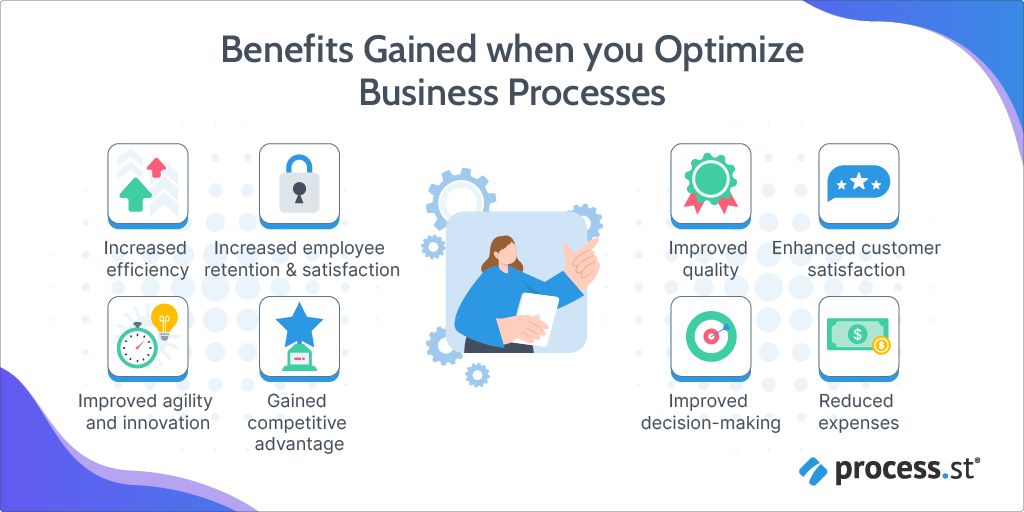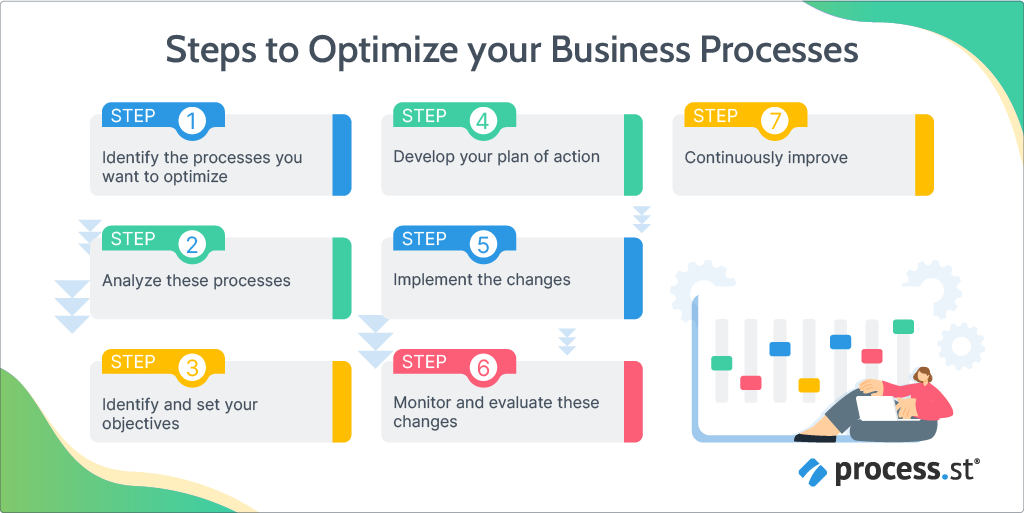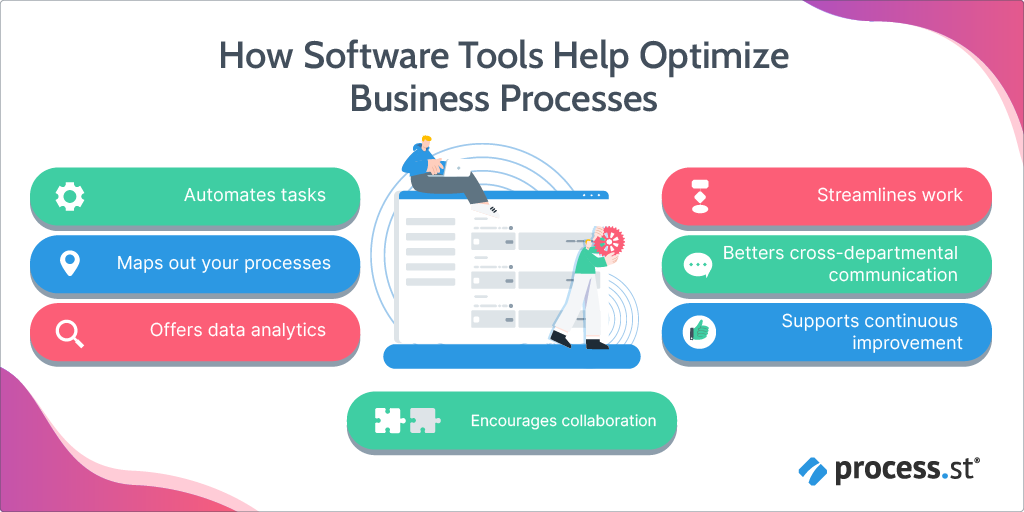Get work done right, and right-on-time with our industry leading BPM platform.
A Complete Guide to Optimize Business Processes
Organizations need to know how to optimize business processes.
But why?
In today’s fast-paced and ever-changing business environment, organizations are under constant pressure to do more with less. They are expected to deliver high-quality products and services, meet customer demands, and remain competitive in their respective markets, all while keeping costs under control.
One of the most effective ways to achieve these objectives is by optimizing business processes. Business process optimization involves the systematic review, analysis, and improvement of workflows, procedures, and operations within an organization.
By optimizing their processes, organizations streamline their workflows, reduce errors, improve efficiency, and enhance their overall performance. This, in turn, helps them meet customer demands, improve profitability, and achieve sustainable growth.
That’s why efficient business processes have become a critical priority for businesses of all sizes and industries, and failure to do so can lead to lost opportunities, decreased efficiency, and reduced competitiveness. So, how can you optimize your business processes? Let’s dive right in!
- What is business process optimization?
- Why is business process optimization important?
- What does it mean to optimize business processes?
- Examples of how to optimize business processes
- Benefits gained when you optimize your business processes
- Challenges of business process optimization
- Steps to optimize your business processes
- How software tools help optimize processes
- Optimize business processes with software tools
- Optimize business processes & make future operations easier
What is business process optimization?
Business process optimization refers to the systematic approach of improving and streamlining the various processes within an organization to enhance efficiency, reduce costs, and increase overall effectiveness. These processes can include anything from operational workflows and production procedures to administrative tasks and customer interactions.
The primary goal of business process optimization is to eliminate inefficiencies, bottlenecks, redundancies, and other issues that might hinder the organization’s ability to deliver products or services efficiently and meet its objectives. This involves analyzing existing processes, identifying areas for improvement, and implementing changes to achieve better results.
Key steps involved in business process optimization include:
- Process analysis: This involves thoroughly examining the current processes to identify their strengths, weaknesses, bottlenecks, and opportunities for improvement. This can be done through data analysis, process mapping, and input from employees who work with these processes.
- Goal setting: Clearly defining the goals and objectives of the optimization efforts. This could involve setting specific targets such as reducing cycle times, minimizing errors, or enhancing customer satisfaction.
- Redesign and improvement: After identifying areas that need improvement, organizations can redesign processes to eliminate unnecessary steps, automate tasks, and make workflows more efficient. This might involve adopting new technologies, revising procedures, or reallocating resources.
- Automation and technology integration: Implementing technology solutions, such as workflow automation software or specialized tools, to streamline processes and reduce manual intervention. Automation can help reduce errors, improve consistency, and accelerate task completion.
- Measurement and monitoring: Defining key performance indicators (KPIs) to measure the effectiveness of the optimized processes. Regularly monitoring these KPIs helps organizations track their progress and make further adjustments as needed.
- Continuous improvement: Business process optimization is an ongoing effort. Organizations should continuously assess and refine their processes to adapt to changing business environments, customer demands, and technological advancements.
Why is business process optimization important?
Business process optimization is crucial for organizations because it helps them work smarter, not harder. By identifying and eliminating inefficiencies, you can improve efficiency, reduce costs, and enhance overall quality.
This leads to faster task completion, better resource allocation, and improved customer satisfaction. Optimization also promotes innovation, agility, and a competitive edge. Employees are more engaged, compliance is better managed, and the organization becomes more adaptable to change.
What does it mean to optimize business processes?
Optimizing ongoing processes means improving the efficiency, effectiveness, and overall performance of the processes that an organization uses to carry out its operations. This involves:
- Identifying and analyzing the processes
- Assessing their strengths and weaknesses
- Making changes to streamline and improve them
Business process optimization involves a continuous cycle of analysis, improvement, and monitoring to ensure that the processes are functioning at their best. It often includes the use of data and technology to:
- Automate or simplify tasks
- Eliminate redundancies workflows
- Speed up workflows
The ultimate goal is to reduce costs, increase productivity, and improve customer satisfaction.
Examples of how to optimize business processes
Here are some specific examples of how organizations can optimize their complex processes:
Lean Six Sigma
Implementing a methodology like Lean Six Sigma helps organizations to identify and eliminate waste in their processes. This involves mapping out workflows, analyzing data, and making changes to streamline and improve processes. Lean Six Sigma also encourages a culture of continuous improvement and empowers employees to identify and solve problems.
Customer relationship management (CRM)
Adopting a CRM system lets organizations manage customer interactions more efficiently and effectively. A CRM system helps to automate tasks like lead generation, sales tracking, and customer service inquiries, and provides valuable insights into customer behavior and preferences.
Business process management (BPM)
Implementing a business process management tool helps organizations automate and optimize their individual processes. A BPM system lets companies apply performance monitoring, process modeling, and workflow automation, which ensures that processes are standardized and consistently followed across the organization.
Robotic process automation (RPA)
Adopting RPA technology empowers organizations to automate routine, repetitive tasks like data entry, document processing, and invoicing. RPA reduces errors, speeds up workflows, and frees up time for more strategic tasks.
Continuous improvement
Building a culture of continuous improvement can help organizations identify and implement process optimization opportunities on an ongoing basis. This involves regularly reviewing and analyzing performance data, soliciting feedback from employees and customers, and empowering employees to suggest and implement improvements.
Benefits gained when you optimize your business processes
Optimizing your current processes provides several advantages for organizations, including:

Increased efficiency
By optimizing processes, organizations streamline workflows and eliminate waste, resulting in increased efficiency and productivity.
Reduced expenses
Organizations reduce costs and improve profitability when they automate recurring tasks. That’s because efficiency is improved and processes are more streamlined.
Improved quality
Optimizing processes reduces errors and improves the quality of products or services delivered to customers.
Enhanced customer satisfaction
By delivering products or services more quickly and with greater consistency, organizations improve customer satisfaction and loyalty.
Competitive advantage
Organizations that optimize their complex processes differentiate themselves from competitors and gain a competitive advantage in their markets.
Innovation and agility
By freeing up resources and providing the agility needed to innovate and adapt to changing market conditions, organizations develop new products or services and respond to new opportunities.
Better decision-making
By implementing process optimization, organizations gain better insights into their operations and make more informed decisions.
Improved employee satisfaction
Optimized processes help employees to work more efficiently and reduce frustration and burnout, resulting in increased job satisfaction and retention.
Challenges of business process optimization
Here are some of the most common challenges managers might come across when they optimize their key processes:
Resistance to change
Employees may be resistant to changes in their workflows, technologies, or responsibilities. This might make it difficult to implement new processes and systems.
Lack of resources
Optimizing inefficient processes requires significant resources, including time, money, and expertise. Organizations may struggle to allocate the necessary resources to support optimization efforts.
Complexity of processes
Some business processes may be highly complex, involving multiple steps and stakeholders. This may make it difficult to identify inefficiencies and implement changes.
Lack of data and metrics
Organizations may lack the data and metrics needed to analyze processes and track performance. This makes it difficult to identify areas for improvement and measure the impact of optimization efforts.
Limited buy-in from stakeholders
Optimizing ongoing processes may involve multiple stakeholders, including employees, customers, and suppliers. It could be challenging to get buy-in and collaboration from all stakeholders to implement business process changes.
Inadequate communication
Communication is critical in optimizing effective business processes. If stakeholders are not informed of changes or are unclear about their roles and responsibilities, it’ll likely lead to confusion and resistance.
Unforeseen consequences
Optimization efforts may have unintended consequences, such as reducing flexibility or increasing risk. Organizations must carefully evaluate potential risks and mitigate them appropriately.
Steps to optimize your business processes
A good business process optimization technique will help you get the most out of your processes. Here are some steps to help you optimize your business processes:

Identify the processes to optimize
The first step in optimizing processes is to identify the processes that need improvement. You want to:
- Conduct a process audit
- Map out workflows
- Analyze performance data
- Identify areas of inefficiency
Analyze the processes
Once the processes have been identified, the next step is to analyze them in detail. During this phase, you want to:
- Break the process down into smaller steps
- Identify bottlenecks
- Analyze the inputs, outputs, and resources required for each step
Set measurable goals
Based on the analysis of the processes, set specific and measurable goals for optimization efforts. These key metrics can include:
- Reducing cycle time
- Eliminating waste
- Improving quality
Develop a plan
Develop a plan to optimize the processes, which should include specific actions to achieve your business goals and objectives. During the phase, your measurable goals should be:
- Apply new technologies
- Streamline workflows
- Standardizing processes
Implement changes
Execute the changes identified in the optimization plan. This might look like:
- Training staff
- Updating procedures
- Apply new software or technologies
Monitor and evaluate
Once the changes have been carried out, it is important to monitor and evaluate their effectiveness. This involves:
- Tracking performance metrics
- Analyzing data
- Soliciting feedback from employees and customers
Continuously improve
Finally, it is important to continuously improve the processes over time. During this step, you want to:
- Seek out new opportunities for optimization
- Adapt to changing market conditions
- Maintain a culture of continuous improvement across the organization
How software tools help optimize processes
Software tools are very helpful for companies that want to optimize their ongoing processes. Here are some ways software tools help with business process optimization:

Automate tasks
Software tools automate repetitive or time-consuming tasks, freeing up time for employees to focus on more complex tasks that require human expertise.
Map processes
Software tools allow you to visually map out processes, which makes it easier to identify inefficiencies and bottlenecks.
Provide data analytics
Businesses are enabled to track performance, make data-driven decisions, and identify areas of improvement with effective process management. That’s because software tools offer real-time data and analytics.
Enable collaboration
Business process software tools facilitate collaboration among team members. This encourages shared access to data and resources and enables real-time feedback and communication.
Streamline workflows
Pre-defined workflows and templates are available when companies use business process optimization software. These workflows reduce errors and eliminate redundancies, which leads to peak efficiency.
Enhance cross-departmental communication
Business process improvement software improves communication by providing centralized repositories for documents and information. Real-time messaging and collaboration features are also available, which improves cross-departmental communication and offers operational excellence.
Support continuous improvement
Your chosen business process optimization tools support continuous improvement efforts. Companies are empowered to track and measure performance over time, identify areas for further optimization, and implement changes as needed.
Optimize business processes with software tools
There are many business process optimization tools available that can help optimize complex processes. Here are some of the best tools to choose from:
Process Street
Process Street is a no-code, cloud-based process management tool designed to help organizations optimize their business processes. It offers features such as process mapping, automation, and collaboration to help businesses streamline their workflows and improve efficiency.
The platform enables businesses to create and manage workflows, track progress, and identify areas for continuous improvement. Additionally, it provides templates for various processes, enabling organizations to get started with workflow management quickly and easily.
Tallyfy
Tallyfy is a business process automation tool that is built to help manage and optimize business processes. It offers a wide range of features, including process modeling, task management, workflow automation, customizable forms, workflow management, and reporting/analytics. With Tallyfy, users can map out their business processes and identify areas where improvements can be made.
Nintex
Nintex is a low-code business process automation tool that helps companies discover, automate, and optimize processes. The platform provides a wide range of features including workflow automation, intelligent forms, mobile applications, and analytics.
The platform helps businesses optimize their processes by identifying inefficiencies and bottlenecks in their workflows, enabling them to streamline their operations, and increase productivity. Companies can also monitor and measure the performance of their workflows and make data-driven decisions to optimize their processes further.
Appian
Appian is a low-code business workflow management tool that enables companies to design, develop, and deploy custom workflows in a visual way, without requiring extensive technical expertise.
This software tool offers features such as task management, document management, and intelligent forms that can help companies optimize their business processes. Appian enables collaboration between business and IT teams, providing visibility and control over the entire process lifecycle.
Bizagi
Bizagi is a workflow management and automation platform that enables companies to model, design, and automate their business processes in a visual way. The platform offers features such as process modeling, workflow automation, and analytics that help companies optimize their business processes. Bizagi’s low-code platform allows companies to design and deploy custom workflows quickly, without requiring extensive technical expertise.
Optimize business processes & make future operations easier
Effective business processes provide organizations with greater agility and flexibility. This enables them to rapidly adapt to changing market conditions or customer needs.
Real-time analytics and data are also offered when optimized processes are in place. From this information, companies are encouraged to identify areas for improvement and make data-driven decisions.
The benefits of process optimization are far-reaching and have a significant impact on future operations, making them easier and more efficient. But ultimately, by optimizing business processes, organizations can position themselves for long-term success and achieve sustainable growth.







 Workflows
Workflows Projects
Projects Data Sets
Data Sets Forms
Forms Pages
Pages Automations
Automations Analytics
Analytics Apps
Apps Integrations
Integrations
 Property management
Property management
 Human resources
Human resources
 Customer management
Customer management
 Information technology
Information technology


